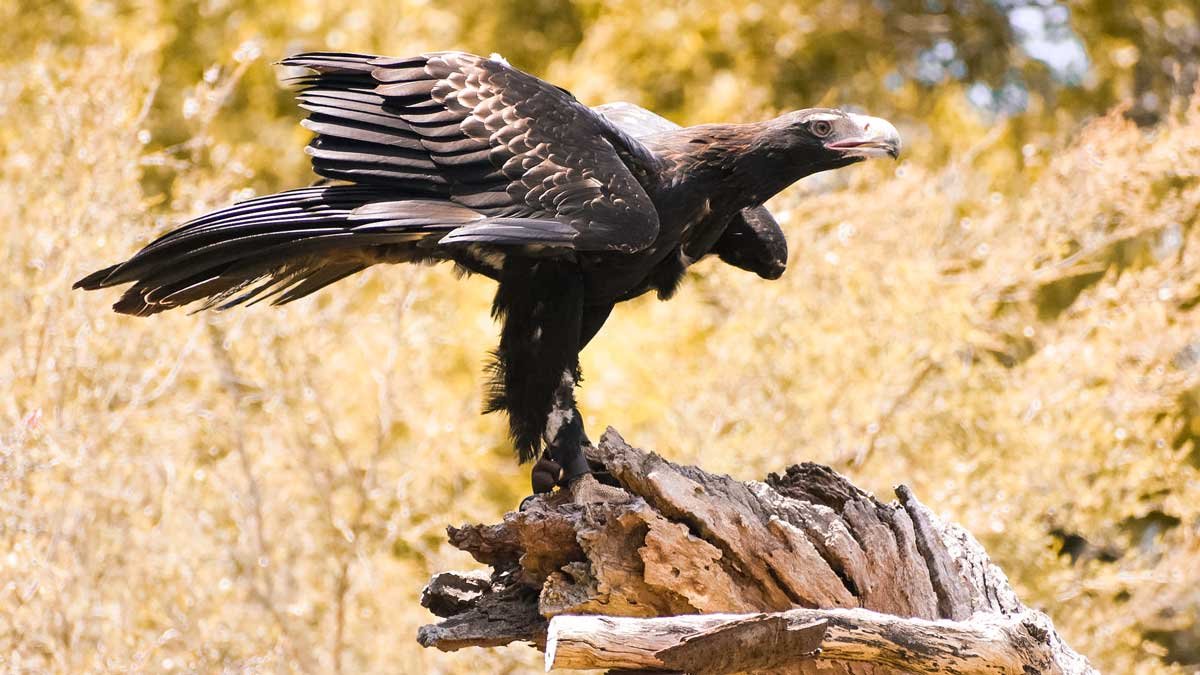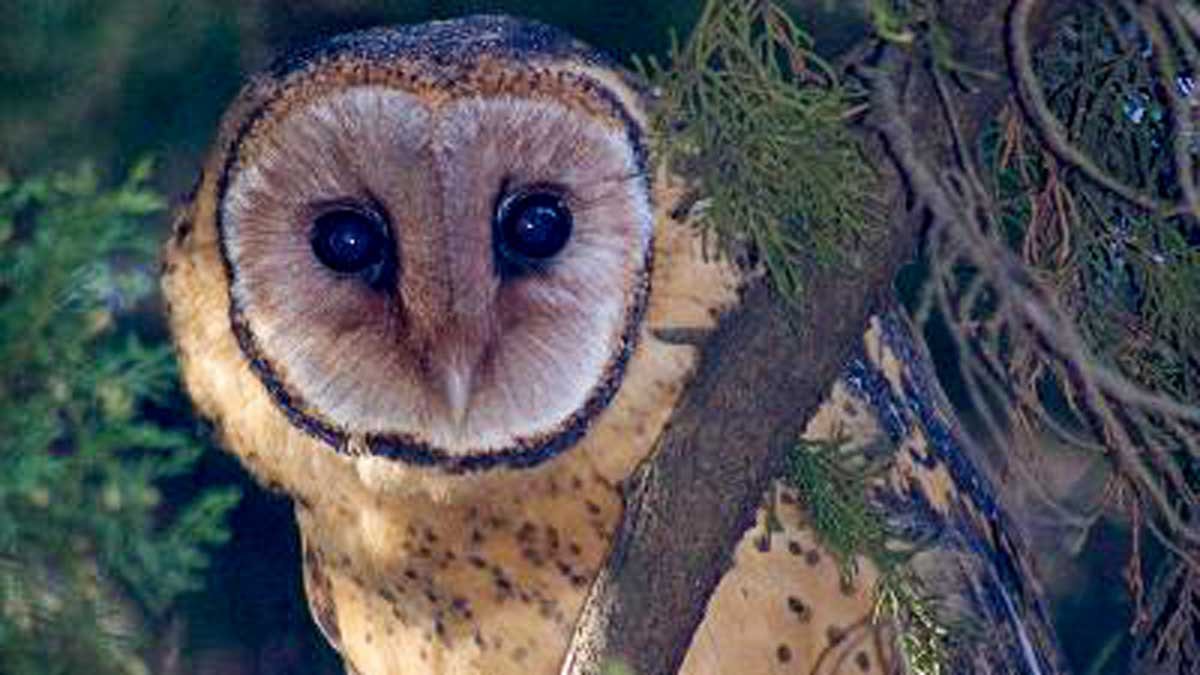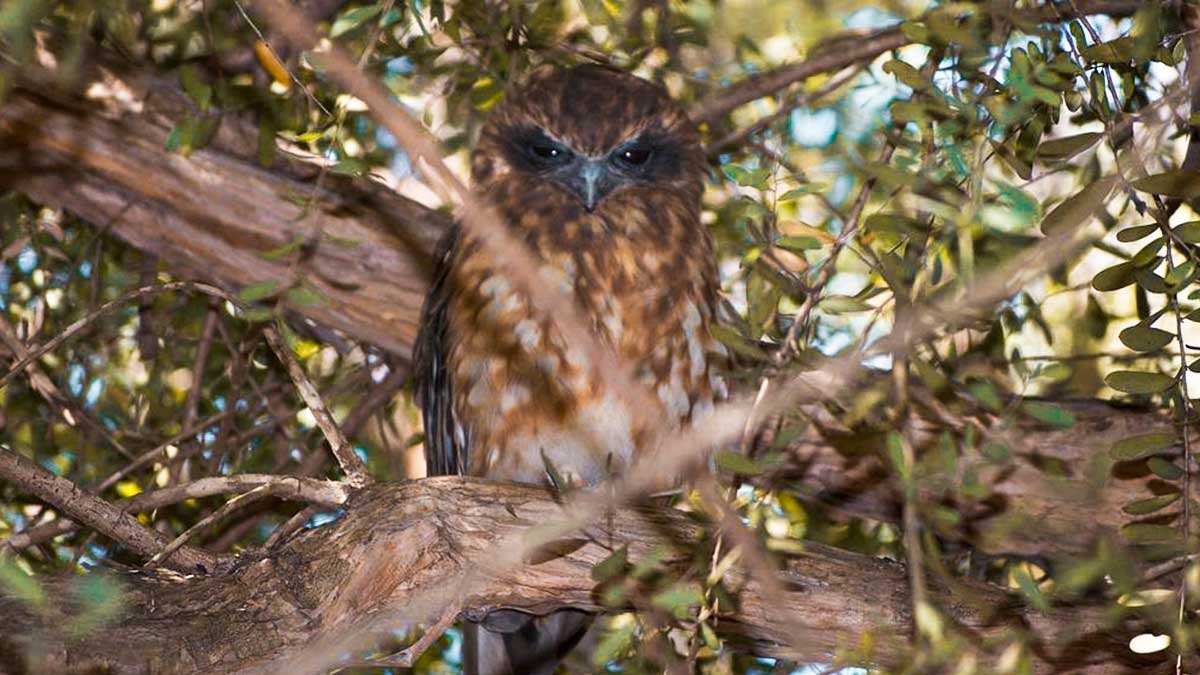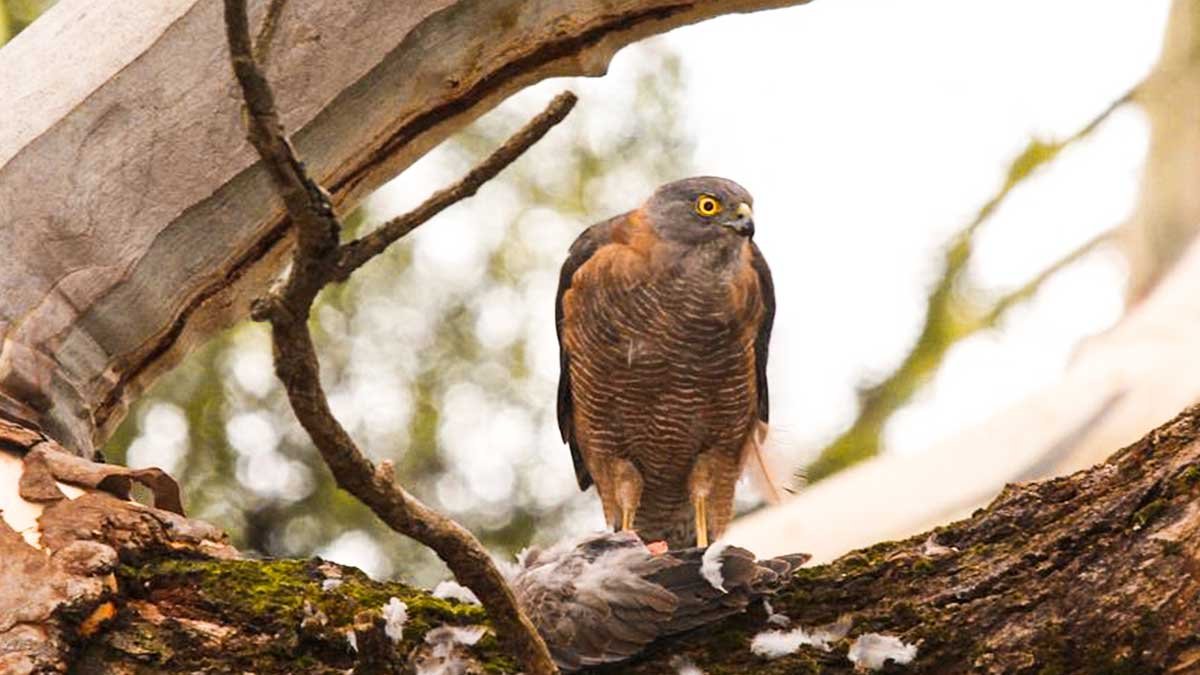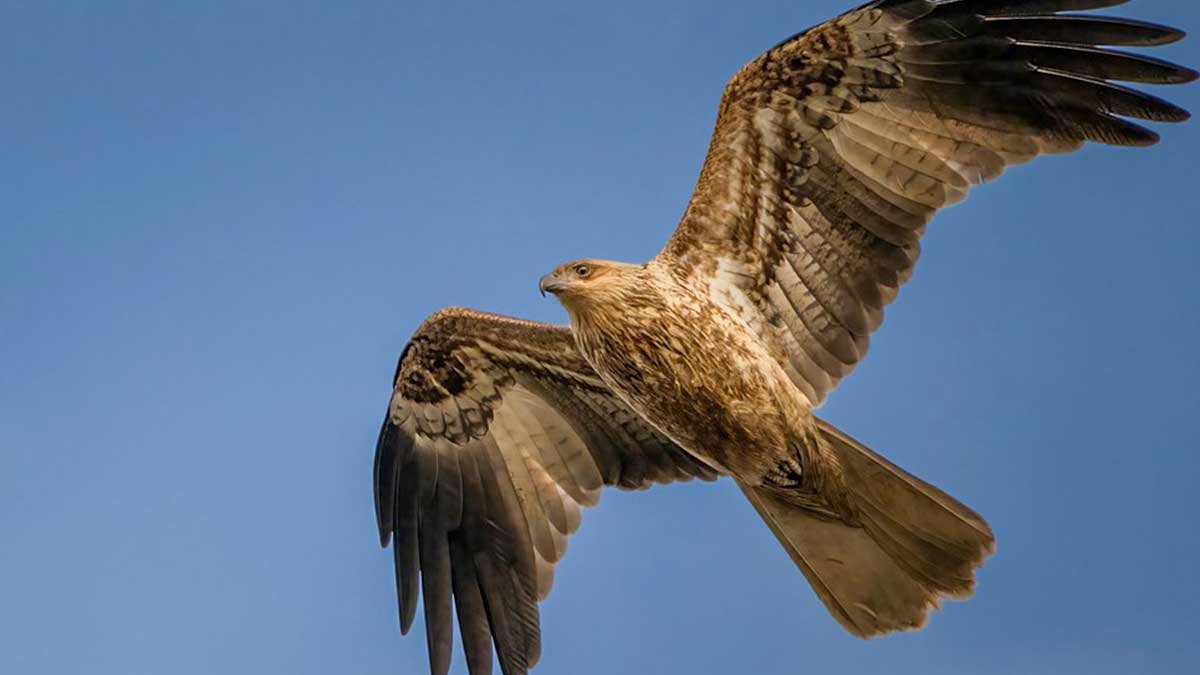Written for Bonorong by Pink Lemonade Social
Tasmania is home to 383 species of birds, and most of these are widespread and common. You can find 13 native species of birds of prey in Tasmania, which include the wedge-tailed eagle, the Tasmanian masked owl and the Southern Boobook. These predators are important as they stabilise populations, reduce introduced pest numbers and promote a healthy bush ecosystem. However, several of these birds of prey are critically endangered, despite being protected by endangerment laws. Read on to discover the list of beautiful raptors that call Tasmania home.
What is a Bird of Prey?
Birds of prey are an animal-eating raptor that is distinguished by its hooked bill and sharp claws. Birds of prey are the daytime predators that swoop down and attack with their claws. Eagles, hawks, vultures, ospreys, buzzards, and falcons are all members of this family, which are known as raptors. As the top predator in the avian food chain, they prey on a wide variety of animals, including other birds, small mammals and marsupials, large reptiles, fish, and so on.
Talons, beaks, and wing spans are frequently used to identify these birds. The upper beak of raptors has a 'hook' at the front that is designed for puncturing and tearing prey. Tawny Frogmouths are often mistaken for Owls, but they are not, and thus they are not a Raptor even though they may share some similarities.
Tasmanian Wedge-Tailed Eagle
Tasmanian wedge-tailed eagles (Aquila audax fleayi) are the largest bird of prey found in Australia with female eagles growing larger than their male counterparts. These birds can weigh up to 5.5 kg and have a wing span of up to 2.2 m. They are classified as their own subspecies of wedge-tail eagles as they have been isolated from the mainland populations for over 10,000 years. You can tell how old a wedge-tail eagle is from the colour of its feathers, light brown feathers indicate it is a young chick whereas eagles that are darker and almost black in appearance are much older. In the wild this species can live up to 20 to 25 years old but are classified as mature once they reach the age of 6. This species of eagle also mates for life and equally shares the responsibility of caring for their chicks and looking after the nest. Wedge-tailed eagles are identified by their tail that is long, dark, and pointed, and the legs are feathered all the way down to the feet. It has the potential to appear very long. Juveniles have a golden blond nape (back of the neck), which gets darker as they get older.
Fun Fact:
Baby wedge-tailed eagles are actually called eaglets and a female eagle will hatch two eggs each time she nests.
Image: XNuytsia@Tas (Flickr)
Tasmanian Masked Owl
Tasmanian Masked Owls (Tyto novaehollandiae castanops) are a subspecies of Masked Owl and are found in eucalypt forests and woodlands within Tasmania. They can weigh up to 1.26 kg and have a wingspan of up to 1.3m. They have white heart-shaped faces and their feathers on their back are a combination of browns and greys. Their upper chest is whitish in colour and is speckled. Females are much darker in colour and larger than the males, ranging from 43 to 57 centimetres in length, compared with the males’ 35 to 42 centimetres. These owls are nocturnal, so they hunt at night for small mammals such as rabbits, possums and smaller birds, and are rarely seen or observed. Tasmanian Masked Owls pair for life and will nest in the hollows of old-growth trees. Tasmanian Masked Owls are endangered due to threats that include; clearing of habitat & nesting trees and competition with other native species for food.
Fun Fact:
Tasmanian masked owls are larger than masked owls that are found on the mainland of Australia.
Southern Boobook
The Southern Boobook (Ninox novaeseelandiae), also known as the Tasmanian spotted owl is found throughout Tasmania, across most of mainland Australia, New Zealand and a few other neighbouring Islands such as Timor. The Southern Boobook is the smallest owl in Australia and is also the most common species of owl, as it can be found in every state; Southern Boobooks can be found in a wide range of habitats, including dense forest and open desert.. They have a disc shaped face that is a lighter brown with large yellow eyes, that help them see at night. These Tasmanian owls are more heavily spotted with white on their chest but have dark brown feathers on their back. At night they hunt for insects such as beetles, caterpillars and moths, but also won’t give up an opportunity to feed on smaller animals like mice.
Fun Fact:
The Southern Boobook is often referred to as a 'Mopoke' owl which is named after its call, as at night they make a distinctive 'boo-book' or 'mo-poke' sounding hoot.
Peregrine Falcon
The Peregrine Falcon (Falco peregrinus) has a body length of 34 to 58 cm and a wingspan from 74 to 120 cm, making it a medium-sized raptor. But like many birds of prey, the females are about 30% larger than the males with them weighing around 1.2kgs compared to 0.6kgs. An adult falcon usually has bluish black feathers on their backs and wings and white chest and underparts which are horizontal lined with bands of dark brown or black. Their beak is notched near the tip which is an adaptation that helps falcons to sever their prey’s spinal cord; sounds painful but is actually a very quick and humane death. The Peregrine Falcon hunts at dawn and dusk, when their prey is most active, which usually includes smaller birds such as silver gulls, crows, parrots and galahs. The Peregrine Falcon requires open space in order to hunt, so will usually hunt over water, valleys and fields where they can search for prey either from a high perch or from the air.
Fun Fact:
The Peregrine Falcons is arguably the fastest animal in the world and have been recorded at speeds faster than 300 km/hr; they move so quickly that they can make a jet-like sound when diving.
Grey Goshawk
The Grey Goshawk (Accipiter novaehollandiae), is a large, all-white raptor that can grow to a length of 55 centimetres and a wingspan of 110 centimetres, with some having a pale grey head and back and dark grey wingtips. The female birds are almost twice as heavy as males and usually weigh around 700g compared to males who weigh around 350g. Typically, they build their nests near a body of water in a mature wet forest; although birds may be found in more open woodland and on the outskirts of cities usually close to a waterway such as a river or stream. The majority of nests are found in the north and west of the state, but smaller breeding populations are also found in the south-east and north-east. Using perches high in the forest canopy, they hunt small mammals, birds, insects, and even carrion occasionally. In particular, the loss of mature wet forests, particularly blackwood swamps, is threatening the Grey Goshawk's survival. Population estimates put the Tasmanian population at less than 110 breeding pairs; the species is also vulnerable to shootings and powerline accidents as well as collision and poisoning. Their diet consists of small mammals and insects but usually other birds that they swoop down on and catch with their talons.
Fun Fact:
Due to them being larger in size, female Grey Goshawks will hunt much larger prey such as currawongs, gamebirds and even herons compared to their male counterparts.
White-bellied Sea Eagle
The White-bellied Sea Eagle (Haliaeetus leucogaster) has a white head, chest and underparts, and a dark grey back and wings. All have bare grey legs and white tails. Females are larger, at 80–90 cm in length and weighing 2.5–4.5 kg while males are 66–80 cm long and weigh 1.8–3 kg. The wingspan of this eagle ranges from 1.78 to 2.2 m and their feet have long talons that they hunt with. The White-bellied Sea Eagle has a carnivorous diet and consumes a wide variety of prey which also includes carrion. It often catches fish and other aquatic animals by flying low over the water and clutching its prey with its talons. The White-bellied Sea Eagle has also been seen diving for fish that swim close to the water surface, and on sunny days the eagle will angle itself to fly directly towards the sun to avoid casting any shadows on the water and therefore goes undetected by potential prey.
Fun Fact:
The white-bellied sea eagle has a lifespan of 30 years in the wild.
Image: @sunphlo / Flickr
Collared Sparrowhawk
The Collared Sparrowhawk (Accipiter cirrocephalus) is an elegantly built, medium-sized raptor with bright yellow eyes that seem to stare straight ahead in a surprised state. There is a complete chestnut half-collar on the upper body and the side of the head, which are slate grey. The short, rounded wings and finely barred rufous underparts give this bird a striking appearance. At the tip, the tail is long and slender. Both sexes look the same, but males are slightly smaller than females (35-38cms). Collared Sparrowhawks are also known as Chickenhawks. The middle toe of the Collared Sparrowhawk is especially long, with long, fine yellow legs. Collared Sparrowhawks feed primarily on flying prey, such as sparrows and chickens. To catch birds at their roost sites, they hunt during the day and also at dawn and dusk. Before killing, plucking, and eating their prey, they use their very long middle toe to clutch it. The Collared Sparrowhawk nests in the fork of a tree, usually high in the foliage, where it constructs a flat nest of twigs and sticks. Fresh leaves line the interior of the nest.
Fun fact:
The male sparrowhawk can only go two to three days without eating, whereas the female, which has a larger body, can go for up to eight days without eating and they maintain a healthy population by weeding out the weak among their own species.
Brown Goshawk
Brown Goshawks (Accipiter fasciatus) can be seen flying over most of Australia, their flight style characterised by frantic flapping interspersed with short glides. Red-brown underparts are finely barred with white on slate-grey to brown upperparts with a red-brown collar across the upper nape of the neck. The long, rounded tail is grey with dark bars, and the long, rounded wings are dark brown to grey above and buff to reddish brown below. A rusty brown feathering adorns the thighs of these long-legged creatures. Compared to females, males are smaller in stature and weight; females weighing roughly 350g while males weigh 220g. The average wingspan is 75-95cm with a body that is 40-55cm. Brown, streaked plumage with grey-brown eyes distinguishes the young birds from the adults.
Birds, small mammals, reptiles, and insects are all prey for these predators. Their preferred method of hunting is to burst out of a hidden perch and surprise unsuspecting prey. In the beginning, small birds make a lot of noise, but as time goes on, they tend to forget about the goshawk and go back to their normal routines. Then the raptor has the ability to pounce on any bird that isn't paying attention. Rabbit is a primary prey item for Brown Goshawks; they also eat small mammals like birds, reptiles and insects, and occasionally, carrion (dead animals). Large stick nests are built on a horizontal limb of tallest tree, often near a waterway or forest edge. A raptor's nest may be recycled from time to time, even using other bird of prey nests or their nest from last season. Eucalyptus leaves are used to line the nest. Both parents are fiercely protective of the nest and its immediate surroundings.
Fun fact:
Young brown goshawks disperse widely from their parents to find and establish their own breeding territories, with distances of up to 900 km not uncommon.
Image: Wayne Butterworth / Flickr
Swamp Harrier
Soaring on upswept (v-shaped) wings low over saltmarsh and wetland habitats, the reddish-brown Swamp Harrier (Circus approximans) has a white rump and is the only large bird of prey that can be seen in this way. The wingspan is 118 to 145 cm, and the body length is 48 to 62 cm. Usually arriving in Tasmania in the early spring and departing in the autumn, this migratory bird can be found overwintering in the Derwent's wetlands and saltmarshes. The Swamp Harrier’s habitat includes saltmarshes, tidal flats and wetlands, and it is one of the few Australian raptors, that migrate seasonally. Harriers often travel across Bass Strait to avoid the harsh winter conditions in Tasmania by spending the cooler months on the mainland before returning in late winter and early spring to breed. Autumn in south-eastern Australia is a time of year when harriers can be seen flying over wetlands and farmland, searching for rabbits and other small prey. To catch small animals like rabbits, rodents, snakes, and birds it is known to drop down above its prey. When hunting, they use a technique known as "quartering," in which they fly low to the ground or water before descending on their prey. Swamp harriers build their nests in reeds and tall grasses on the ground and whilst the male hunts to feed the hatchlings, he transfers food to the female in the air, so the female can feed the young.
Fun fact:
Swamp harriers have a few enemies which include magpies, masked lapwings (that dive bomb them) and European starlings that form swarms to mob individuals.
Nankeen Kestrel
The Nankeen Kestrel (Falco cenchroides) is found throughout Australia, but only on rare occasions in Tasmania. It is also known as the Australian Kestrel. The Nankeen kestrel is a small, slim falcon with a wingspan of 66 to 78 cm and a length of 28 to 35 cm
with a slender appearance. The upper body is mostly rufous with some dark streaking, with black tips on the wings. The undertail is finely barred with black, with a broader black band towards the tip, and the underparts are pale buff with black streaks. Males have a greyish crown and tail, though the extent of the grey varies from individual to individual. Females have a larger body size than males. Kestrels prefer open country, such as grasslands and farmland, and will avoid dense forests unless they have been cleared. Nankeen kestrels hover expertly, and can often be spotted perched on powerlines, poles, and other structures.
The Nankeen Kestrel builds its nest in a variety of places, including tree hollows, caves, ledges on building exteriors, and even on the ground. The nest can be anything from a simple scrape in the dirt, a ledge, tree hollow to a nest of sticks or mud that another bird has abandoned. Small mammals (especially mice), small birds, lizards, and insects are among the prey they pursue. Smaller prey can be consumed while flying, but larger prey must be returned to a perch. Kestrels are drawn to mouse plagues and catch their prey by dropping onto them or pouncing onto them.
Fun fact:
While often mistaken for peregrine falcons, Nankeen kestrels sound markedly different; usually a rapid shrill "kee kee kee " sound and a wavering "keer, keer, keer".
Image: kookr/David Cook - Flickr
Brown Falcon
The Brown Falcon (Falco berigora) is an Australian bird of prey that can be found all over the country and is one of the most commonly seen. It can reach a length of 50cm, have a wingspan of 88-115cm with males weighing 310-590g and females 430-860g. Plumage colours on the Brown Falcon range from very dark to light brown on top an off-white underneath. It has a distinctive tear-stripe below the eye on the sides of its head, which is brown. Brown Falcons prefer open grasslands and agricultural areas where they can spot their prey more easily. Brown falcons are lone wolves. They are frequently seen perched on poles, or spotted high in the sky hovering or flying back and forth, scanning for prey. The falcon's beak contains specialised teeth that it uses to sever the spine of its prey. They are opportunistic raptors that feed on a variety of prey, including mammals, birds, snakes, and insects, the most common of which are introduced rabbits, especially during the summer months
Fun fact:
In the south, brown falcons breed from June to November, and in the north, from April to June. To attract a female in the breeding season, males perform aerial acrobatics.
Australian Hobby (C) Con Duyvestyn 2015 birdlifephotography.org_.au
Australian Hobby
The “Little Falcon” or "Little Duck Hawk" is one of the several names for the Australian Hobby (Falco longipennis, which is seriously misleading. Hobbies frequently consume birds, however because they are smaller than most, they are unable to kill larger birds. In actuality, the Hobby is merely thought of by some as a smaller variation of the similar but larger Peregrine Falcon, which regularly consumes ducks. The Australian Hobby can frequently be spotted hunting in vegetated metropolitan areas as well as in practically any lightly forested region, either low to the ground or just over the treetops. They frequently catch their food—small birds and insects—in the air and can fly in a variety of ways, including quickly and directly with flickering wingbeats, gliding, and soaring. Their harsh chatter is their cry. The Australian Hobby is a medium-sized falcon with long, narrow, pointed, scythe-shaped wings and a long, square-cut tail. With a light half-collar that does not go all the way over the back of its neck, it has a head that is normally dark in colour. The tail also has a delicate white tip. The cere (the very base of the bill) is pale yellow, as are the legs and feet, and the bill is blue-grey towards the base and blackish at the tip. Typically, young birds have darker plumage. The Australian Hobby prefers open, lightly forested settings, particularly those with open forests, woodlands, or mosaics of trees, as well as wooded cropland, forested wetlands, and densely vegetated neighbourhoods.
Fun fact:
The Australian Hobby is a lone and aggressive falcon. Hobbies have been seen soaring and circling during territorial defence to keep away other raptors. Although they have been known to annoy and harass larger birds, hobbies cannot harm them.
Whistling Kite
The Whistling Kite (Haliastur sphenurus) is a large raptor with sandy colouring and a scruffy look. It keeps its wings in a bent M-shape while flying and has a distinct underwing pattern, with a quite rounded and lengthy tail. The wingspan ranges from 120 to 145 cm, and they are long and rounded. Unsurprisingly, the Whistling Kite's unique call is a clear whistle that begins by dropping in scale and then rises to a higher pitch. Birds make this call while perched or flying overhead. During the mating season, they hunt on living animals, particularly rabbits and hares, as well as fish, reptiles, birds, small mammals, and invertebrates. During the non-breeding season, they primarily consume carrion. They may steal food from other raptors and even visit bushfires to capture escaping animals. They frequently soar in a languid looping flight pattern and can be found near water or around fields.
In Tasmania, the Whistling Kite is less common than it is on Australian mainland. In particular, wetlands, open spaces, and forests are where you can find the Whistling Kite. It is also typical around agricultural areas, vineyards, and other places where carrion (dead animals) are present (e.g. abattoirs, rubbish dumps and roadsides).
Due to some breeding pairs staying in a territory all year long and actively defending the region surrounding a nest, the Whistling Kite appears to be monogamous. The big nest platform is made of sticks and is situated in a tall tree. It may be reused and will enlarge over time. Both sexes contribute equally to nest construction and egg incubation, with the female performing the majority of the work. They can reproduce twice or three times per year. After fledging, the young remain with the parents for roughly six to eight weeks.
Fun fact:
The female of the bird is larger than the male, as is the case with many other raptor species. However, there is a considerable disparity in this instance, with females being up to 21% bigger and 42% heavier.
Females can reach a height of 59 cm and have a wingspan up to 120 cm.
Never approach or attempt to touch a raptor
If handled improperly, even the most experienced raptor handler can sustain serious injury. Avoid helping or picking up an injured raptor. If you see an injured raptor please call Bonorong Wildlife Rescue, a Tasmania-wide, 24/7 wildlife rescue service on 0447ANIMAL any time of the day or night.


